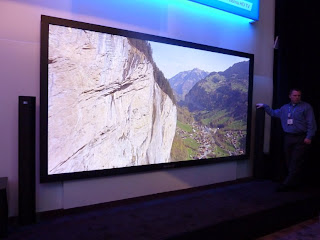Panasonic's 152-inch TV just hit and it's got 4k by 2k resolution, 3D support and several technologies that speed up display and optimize it for displaying 3D by reducing cross talk. Not that you'll be able to afford one.
It'll be about the size of the 150-incher above, plus two inches.
The quad luminous tech brings plasma pictures to full brightness in 1/4th the time, so fast refreshes don't compromise picture intensity and they've managed to refresh pictures frame at a time instead of line at a time, so that alternating right/left images presented for 3D don't suffer from the double effect that some displays show. All in theory.
< Key Features of the new Full HD 3D PDP >
1. Newly developed ultra high-speed 3D drive technology enables 3D display on ultra-large (152-inch), super high resolution (4K x 2K) panels
Using the super-efficient quadruple luminous efficiency technology, Panasonic developed 3D ultra high-speed drive technology. Compared to the conventional full HD panels(4), the technology allows the new panel to achieve the same brilliance at about one-fourth speed. The new 152-inch panel also uses a new technology that enables even and stable discharge. Thanks to this discharge technology, the new panel can provide full HD images for left and right eyes formed with twice the volume of information as regular full HD images across the vast expanse of the screen equivalent to nine 50-inch panels with super high resolution (4,096 x 2,160) - four times the full HD (1,920 x 1,080) specification - while maintaining the brightness.
The new advanced PDP delivers high-quality 3D images, with virtually infinite 5,000,000:1(9) contrast ratio, accurate color reproduction and subtle gradation tones, on the ultra-large screen. With characters in the screen approach the viewers in life size, the new panel creates an overwhelmingly immersive experience.
2. Cross-talk reduction enables clear, high-definition 3D images
Because displaying 3D images involves alternate displays of left- and right-eye images, reducing the overlap (cross-talk) between these images is essential for high-quality 3D images. Unlike 3D LCD panels that use line by line scanning method, PDPs use frame-sequential method that displays images frame by frame very quickly, giving PDPs a tremendous advantage in crosstalk reduction. Incorporating newly-developed phosphors with short luminescence decay time - one third the time of conventional phosphors(4) - as well as illumination control technology, the cross-talk reduction technology has succeeded in minimizing double images.
Enhancing the video reproduction capability of PDP, which has full moving picture resolution, the technology enables crisp and clear, high-quality 3D images by faithfully reproducing video sources.
3. Full HD x 2 frame sequential method
To reproduce 3D images, the new PDP uses the full HD x 2 frame(10) sequential method that displays time sequential images, alternately reproducing discrete full HD (1920 x 1080 pixels) images for the left and right eyes on the display frame by frame. By adopting the method which is used in showing Hollywood 3D films in theaters, the new panel accurately reproduces high-quality 3D images in the living room.














